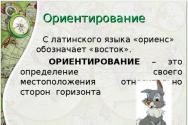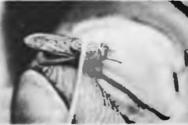Synthesis in biology examples. Characteristics of the main methods for obtaining antibiotics. Questions and tasks for review
Metabolism and energy conversion are the basis of cell life. Energy metabolism in the cell and its essence. The importance of ATP in energy metabolism.
Plastic exchange. Photosynthesis. Ways to increase the productivity of agricultural plants. Biosynthesis of proteins. The gene and its role in biosynthesis. DNA code. Matrix synthesis reaction. The relationship between the processes of plastic and energy metabolism.
Self-test questions:
What is biological synthesis?
Give examples.
Define assimilation.
What is the genetic code? Formulate the main properties of the genetic code?
Where are ribonucleic acids synthesized?
Where does protein synthesis occur? Tell us how the synthesis of 6elka is carried out.
What is dissimilation? Describe the stages of dissimilation.
What is the role of ATP in cell metabolism?
Explain energy metabolism in a cell using the breakdown of glucose as an example.
What types of nutrition of organisms do you know? What organisms are called autotrophic? What groups are autotrophic organisms divided into?
Describe the light and dark phases of photosynthesis.
Why does green plants release free oxygen into the atmosphere as a result of photosynthesis?
What is chemosynthesis?
Give examples of photosynthetic organisms.
What organisms are called heterotrophic?
Give examples.
Section 4. Reproduction of living organisms
The ability to reproduce, or self-reproduction, is one of the most important characteristics of organic nature. Reproduction is a property inherent in all living organisms without exception - from bacteria to mammals. The existence of any species of animals and plants, bacteria and fungi, continuity between parent individuals and their offspring is maintained only through reproduction.
Sexual reproduction refers to the change of generations and the development of organisms based on specialized germ cells formed in the gonads. In the evolution of reproduction, the most progressive method turned out to be by which a new organism develops as a result of the fusion of two germ cells formed by different parents. However, in invertebrate animals, sperm and eggs are often formed in the body of one organism. This phenomenon - bisexuality - is called hermaphroditism. Flowering plants are also bisexual. There are cases when a new organism does not necessarily appear as a result of the fusion of germ cells. In some species of animals and plants, development from an unfertilized egg is observed. This type of reproduction is called virgin or parthenogenetic.
Asexual reproduction is characterized by the fact that a new individual develops from asexual ( somatic) cells.
Self-test questions:
What methods of reproduction do you know?
What is sexual reproduction?
In which organisms does asexual reproduction occur? What forms of asexual reproduction do you know? Give examples.
Why during asexual reproduction are the offspring genetically similar to each other and to the parent?
How does sexual reproduction differ from asexual reproduction? Indicate the differences between meiosis and mitosis.
What is the biological meaning of meiosis? Why do mature germ cells of the same organism carry different combinations of genes?
What are the evolutionary advantages of sexual reproduction over asexual reproduction?
Reactions of synthesis of organic substances occur in the cell simultaneously with the processes of splitting. Complex specific biopolymers (proteins, fats, carbohydrates, nucleic acids) are synthesized from simple substances formed as a result of dissimilation processes. Synthesized organic substances are used to build various cell organelles, enzymes, secretions and reserve substances to replace those used up. All these processes occur with the absorption of energy. The synthesis of substances occurring in the cell is called biosynthesis or
plastic exchange.
At this stage, a total of 2600 kJ of energy is released at a number of intermediate links.
The overall equation for the complete breakdown of glucose at two stages can be written as follows:
According to the method of obtaining organic compounds, all cells are divided into autotrophic and heterotrophic (see section “Botany”).
The ATP formed in this case is sent through the endoplasmic reticulum channels to other parts of the cell where the need for it arises. Thus, from the energy generated during the breakdown of glucose, a total of 80 kJ + 1440 kJ = 1520 kJ is saved for the cell, or 55% of the energy, which turns into potential energy and is subsequently used by the cell. Therefore, the splitting reaction is called energy exchange.
Photosynthesis(color table I) is a unique process of the formation of organic compounds from inorganic substances using light energy. For the first time, the process of photosynthesis and the role of plant chlorophyll in it was described by the outstanding Russian scientist Kliment Arkadyevich Timiryazev (1843-1920). Photosynthesis is a complex multi-stage process that occurs in two phases - light and dark.
Light phase begins with illumination of the chloroplast with visible light. Under the influence of light quanta, some of the mobile electrons of chlorophyll molecules move to a higher energy level and acquire potential energy. Some of these “excited” electrons return to their original place, and the energy released is dissipated in the form of heat. Another part of them, with the participation of carriers, acts as reducing agents and attaches to hydrogen ions that are constantly formed in cells during the dissociation of water molecules (H 2 O =H + +OH -). Hydrogen ions, having added an electron, turn into hydrogen atoms (H + +e - = H) and combine with molecules of carrier substances.
OH - ions, left without hydrogen counterions, give up their electrons to other ions and turn into OH radicals (OH = e - + OH). Interacting with each other, they form water and molecular oxygen (40H = 2H 2 O+O 2).
The process of formation of molecular oxygen during the decomposition of water under the influence of light energy is called photolysis of water. It was first studied and described by the Soviet scientist Alexander Pavlovich Vinogradov (1895 -1975), using the method of labeled atoms. In its mechanism, photolysis of water is similar to electrolysis of water.
In addition, during the light phase, some of the “excited” electrons of chlorophyll and electrons separated from OH - ions participate in the formation of a high-energy phosphate bond during the synthesis of ATP from ADP and inorganic phosphate (P) (ADP + P = ATP).
Thus, during the light phase of photosynthesis, as a result of the absorption of light energy by chlorophyll due to “excited” electrons, photolysis of water occurs with the release of oxygen and the synthesis of ATP.
The dark phase of photosynthesis consists of a series of sequential enzymatic reactions for the binding of CO 2, as a result of which glucose is formed, which serves as the starting material for the biosynthesis of other organic substances of the plant. This process occurs due to the energy of ATP with the participation of hydrogen atoms formed in the light phase (6СO 2 +24Н=С 6 Н 12 O 6 +6Н 2 O).
The overall equation for photosynthesis is:
6CO 2 + 6H 2 O = C 6 H 12 O 6 + 6O 2
The membrane structure of the chloroplast distinguishes between reactive substances.
Photosynthetic productivity- 1 g of organic matter per 1 m2 of leaves in 1 hour. Every year, as a result of photosynthesis, about 400 billion tons of organic matter are formed. The annual oxygen requirement of one person is provided by the functioning of 10-12 middle-aged trees during the growing season. It has been established that the productivity of photosynthesis increases with an increase, up to a certain level, in light intensity, CO 2 content, temperature and humidity of the surrounding air. These patterns are widely used when growing plants in protected soil.
Chemosynthesis was discovered in 1888 by the Russian biologist S. N. Vinogradsky, who proved the ability of some bacteria to assimilate carbon dioxide using chemical energy. There are several groups of chemosynthetic bacteria, of which the most important are nitrophic bacteria, sulfur bacteria and iron bacteria. For example, nitrifying bacteria obtain energy for the synthesis of organic substances by oxidizing ammonia to nitrous and then to nitric acid; sulfur bacteria - oxidizing hydrogen sulfide to sulfates, and iron bacteria - converting iron oxide salts into oxide salts. The released energy is accumulated in the cells of chemosynthetic bacteria in the form of ATP. The process of chemosynthesis, in which organic matter is formed from CO 2, proceeds similarly to the dark phase of photosynthesis.
Thanks to the activity of chemosynthetic bacteria, large deposits of saltpeter and bog ore accumulate in nature.
Protein biosynthesis occurs in every living cell. It is most active in young growing cells, where proteins used to build their organelles are synthesized, as well as in secretory cells, where enzyme proteins and hormone proteins are synthesized.
The main role in determining the structure of proteins belongs to DNA. A piece of DNA consisting of several hundred nucleotides containing information about the structure of one protein is called a gene. One DNA macromolecule contains several hundred genes. The molecule contains a code about the sequence of amino acids in a protein in the form of specifically combined nucleotides. The essence of the DNA code is that each amino acid corresponds to a section of a DNA chain of three adjacent nucleotides - triplets
. For example, A - - C - A corresponds to the amino acid cysteine, A - A - C - leucine, T - T - T - lysine, etc. There are 20 different amino acids, the number of possible combinations of 4 nucleotides of 3 is 64. Therefore, triplets more than enough for all amino acids.
Protein biosynthesis is a complex multi-stage process, representing a chain of synthetic reactions that proceed according to the principle of matrix synthesis. The essence matrix synthesis reactions
is that new protein molecules are synthesized in exact accordance with the plan laid down in the structure of existing DNA molecules. These reactions ensure the exact specific sequence of monomers in the synthesized polymers.
In protein biosynthesis, the following stages are determined, occurring in different parts of the cell.

Synthesis of mRNA (occurs in the nucleus). The information contained in the DNA gene is transcribed into mRNA. This process is called transcription (from the Latin “transcriptis” - rewriting).
In this case, opposite each nucleotide of one of the DNA chains there is a complementary nucleotide of i-RNA. mRNA molecules are individual, each of them carries the information of one gene. Connection of amino acids with tRNA molecules (occurs in the cytoplasm). tRNA molecules consist of 70-80 nucleotides. The tRNA chain contains a number of nucleotide units that are complementary to each other. As they approach each other, they stick together to form a structure resembling a clover leaf (61). A certain amino acid is attached to the “petiole” of the leaf, and at the “top” of the leaf is located code triplet
nucleotides corresponding to a specific amino acid. Each of the 20 amino acids has its own tRNA."Protein Assembly"
From the cytoplasm, t-RNAs with amino acids “hung” on them approach the ribosomes and, with their code end, touch the triplet of mRNA nucleotides currently passing through the ribosome. At this time, the opposite end of the t-RNA with the amino acid enters the site of protein “assembly” and, if the t-RNA code triplet turns out to be complementary to the i-RNA triplet currently located in the ribosome, the amino acid is separated from the t-RNA and becomes part of the protein , and the ribosome takes a “step” one triplet along the mRNA (mRNA triplets corresponding to each of the 20 amino acids, see Appendix).

Having donated an amino acid, the tRNA leaves the ribosome and is replaced by another, with a different amino acid, which makes up the next link in the protein molecule under construction (62). This is how the polypeptide chain of a protein is assembled link by link, and information about the structure of the protein, recorded in mRNA as a sequence of nucleotides, is reproduced on the polypeptide chain of the protein in the form of a sequence of amino acids. This process is called translation (from the Latin “broadcast” - transfer) (see appendix, task 2 and table). When the synthesis of the protein molecule is completed, the ribosome leaves the mRNA. The resulting protein enters the endoplasmic reticulum and through its channels to other parts of the cell, and the ribosome enters another mRNA and participates in the synthesis of another protein. All protein synthesis reactions are catalyzed by special enzymes, and energy is supplied by ATP.
DNA, the carrier of all genetic information in a cell, is not directly involved in protein synthesis (the implementation of this hereditary information). In animal and plant cells, DNA molecules are separated by a nuclear membrane from the cytoplasm, where protein synthesis occurs. An intermediary is sent from the nucleus to the ribosomes, the sites of protein assembly, which carries the copied information and is able to pass through the pores of the nuclear membrane. Such an intermediary is messenger RNA, which participates in matrix reactions.
Matrix reactions are reactions for the synthesis of new compounds based on “old” macromolecules that act as a matrix, i.e., a form, a sample for copying new molecules. Matrix reactions for the implementation of hereditary information, in which DNA and RNA take part, are:
1. DNA replication– doubling of DNA molecules, thanks to which the transfer of genetic information is carried out from generation to generation. The matrix is the maternal DNA.
2. Transcription(lat. transcription- rewriting) is the synthesis of RNA molecules according to the principle of complementarity on the matrix of one of the DNA chains. Occurs in the nucleus under the action of the enzyme DNA-dependent RNA polymerase. Messenger RNA is a single-stranded molecule, and gene copying occurs from one strand of a double-stranded DNA molecule. The language of DNA triplets is translated into the language of mRNA codons. As a result of the transcription of different genes, all types of RNA are synthesized. Then mRNA, t-RNA, r-RNA enter the cell cytoplasm through pores in the nuclear membrane to perform their functions.
3. Broadcast (lat. translation– transmission, translation) is the synthesis of polypeptide chains of proteins on the matrix of mature mRNA, carried out by ribosomes. There are several stages in this process:
Stage one – initiation(beginning of synthesis). In the cytoplasm, a ribosome enters one of the ends of the mRNA (precisely the one from which the synthesis of the molecule in the nucleus began) and begins the synthesis of the polypeptide. The tRNA molecule transporting the amino acid glutamine (GLN tRNA) connects to the ribosome and attaches to the beginning of the mRNA chain (code UAG). Next to the first t-RNA (which has nothing to do with the synthesizing protein), a second t-RNA with an amino acid is added. If the anticodon is t-RNA, then a peptide bond occurs between the amino acids, which is formed by a certain enzyme. After this, t-RNA leaves the ribosome (goes into the cytoplasm for a new amino acid), and mRNA moves one codon.
Second phase - elongation(chain lengthening). The ribosome moves along the mRNA molecule not smoothly, but intermittently, triplet after triplet. The third tRNA with an amino acid binds with its anticodon to the codon of the mRNA. When a complementary bond is established, the ribosome takes another step one “codon”, and a specific enzyme “crosslinks” the second and third amino acids with a peptide bond - a peptide chain is formed. Amino acids in a growing polypeptide chain are connected in the sequence in which the mRNA codons encoding them are located (Fig. 14).
Third stage – termination(end of synthesis) chain. Occurs when the ribosome translates one of the three “nonsense codons” (UAA, UAG, UGA). Ribosomes jump off the mRNA, protein synthesis is completed.
Thus, knowing the order of amino acids in a protein molecule, it is possible to determine the order of nucleotides (triplets) in the mRNA chain, and from it - the order of nucleotide pairs in a DNA section and vice versa, taking into account the principle of nucleotide complementarity.
But in the process of matrix reactions, changes - mutations - can occur. These are gene mutations at the molecular level - the result of various damage in DNA molecules - affecting one or more nucleotides. All forms of gene mutations can be divided into two large groups.
First group- reading frame shift – represents the insertion or deletion of one or more nucleotides. Depending on the location of the violation, one or another number of codons changes. This is the most severe damage to genes, since completely different amino acids will be included in the protein. Such deletions and insertions account for 80% of all spontaneous gene mutations.
The most damaging effects are nonsense - mutations that are associated with the appearance of terminator codons that stop protein synthesis. This can lead to premature termination of protein synthesis, which quickly degrades. The result is cell death or a change in the nature of individual development.
Mutations associated with substitution, deletion or insertion in the coding part of a gene are phenotypically manifested as replacement of amino acids in the protein. Depending on the nature of the amino acids and the functional significance of the damaged area, a complete or partial loss of the functional activity of the protein is observed. This is expressed in a decrease in viability, changes in the characteristics of organisms, etc.
Second group- These are gene mutations with the replacement of nucleotide base pairs. There are two types of base substitutions:
1. Transition - replacement of one purine base with another purine base (A with G or G with A) or one pyrimidine with another pyrimidine (C with T or T with C).
2. Transversion - replacement of one purine base with a pyrimidine base or vice versa (A to C, or G to T, or A to U). An example of a transversion is sickle cell anemia, which occurs due to an inherited disorder of the hemoglobin structure. In the mutant gene encoding one of the hemoglobin chains, only one nucleotide is disrupted, and adenine is replaced with uracil in the mRNA (GAA to HUA). As a result, a change in the biochemical phenotype occurs; in the hemoglobin β-chain, glutamic acid is replaced by valine. This replacement changes the surface of the hemoglobin molecule: instead of a biconcave disc, the red blood cell cells become sickle-shaped and either clog small vessels or are quickly removed from the circulation, which quickly leads to anemia .
Thus, the significance of gene mutations for the life of an organism varies:
· some “silent mutations” do not affect the structure and function of the protein (for example, a nucleotide substitution that does not lead to a substitution of amino acids);
· some mutations lead to complete loss of protein function and cell death (for example, nonsense mutations);
· other mutations - with a qualitative change in mRNA and amino acids lead to changes in the characteristics of the organism;
· some mutations that change the properties of protein molecules have a damaging effect on the vital activity of cells - such mutations cause severe diseases (for example, transversions).
End of work -
This topic belongs to the section:
Introduction. Molecular basis of heredity
Introduction.. genetics from the Greek genesis origin as the science of patterns.. i stage gg period of classical genetics development of Mendelism..
If you need additional material on this topic, or you did not find what you were looking for, we recommend using the search in our database of works:
What will we do with the received material:
If this material was useful to you, you can save it to your page on social networks:
| Tweet |
All topics in this section:
Main types of heredity
Genetics is a science that studies the patterns of heredity and variability of living organisms.
Heredity is the ability of organisms to repeat in generations
Main carriers of heredity
The main carriers of nuclear heredity are chromosomes located in the cell nucleus. Each chromosome has chemical components: one giant DNA molecule
The concept of human karyotype
The number, size and shape of chromosomes are specific characteristics for each type of living organism. Thus, the cells of a hermit crab contain 254 chromosomes, while a mosquito has only 6. Somatic
Chromosome rules
There are 4 rules of chromosomes: The rule of constancy of the number of chromosomes. Somatic cells of the body of each species normally have a strictly defined number of chromosomes (for example
Cellular and mitotic cycles
The cell (life) cycle is a period in the life activity of a cell from the moment of its appearance until the death or formation of daughter cells. The mitotic cycle is a period in the life activity
Reproduction at the organismal level
Gametogenesis is the process of formation of gametes - male and female reproductive cells. Eggs are formed in the female gonads (ovaries) and are large in size
The peculiarities of human reproduction are determined by its specificity as a biological and social being.
The ability to reproduce becomes possible with the onset of puberty, recognized
Nucleic acids
In 1869, Swiss biochemist Johann Friedrich Miescher first discovered, isolated and described DNA from cell nuclei. But only in 1944 O. Avery, S. McLeod and M. Macarthy proved the genetic role
Genetic code and its properties
To carry out gene expression, there is a genetic code - a strictly ordered relationship between nucleotide bases and amino acids (Table 3).
Common abbreviations for
Basic properties of the genetic code
1. Tripletity - one amino acid corresponds to three adjacent nucleotides, called a triplet (codon) (triplets in mRNA are called codons);
2. Station wagon
Levels of organization of hereditary material
There are the following levels of structural and functional organization of the hereditary material of eukaryotes: gene, chromosomal and genomic.
The elementary structure of the organ gene level
Cytological and molecular basis of variability of organisms
Genetics studies not only the phenomenon of heredity, but also the phenomenon of variability. Variability is the property of living organisms to change under the influence of external and internal factors.
Non-hereditary variability
Non-hereditary (phenotypic) variability is a type of variability that reflects changes in the phenotype under the influence of environmental conditions that do not affect the genotype. Degree of her you
Hereditary variability
Genotypic (hereditary) variability is hereditary changes in the characteristics of an organism, determined by the genotype and preserved over a number of generations. It is represented by two views
Mutational variability
A mutation is an abrupt, stable change in genetic material under the influence of external or internal environmental factors, which is inherited. Organism, hereditary
Molecular mechanism of mutations
According to the nature of the change in phenotype, all mutations can be divided into the following groups.
1. Morphological, violating the signs of the physical structure; eyeless, short-fingered
Mutations at the population level
It is believed that any mutation is harmful because it disrupts the interaction of the organism with the environment. However, some mutations cause minor changes in the body and do not pose any particular danger.
The effect of chromosomal mutations on various body systems
The degree of change in the characteristics of an organism due to chromosomal mutations depends on the size of the defective area and on the content of genes important for development in it. To determine the consequences of chromosomal mutations
Consequences of mutation in germ and somatic cells
The effect of a mutation on a person’s phenotype may vary depending on the type of cells in which the change in hereditary structures occurs. Generative mutations or changes in inheritance
Stability and repair of genetic material
The stability of the genetic material is ensured by: a diploid set of chromosomes; DNA double helix; degeneracy (redundancy) of the genetic code;
Antimutagens
The mutation process is the source of changes leading to various pathological conditions. The compensation principle at the present stage involves measures to prevent genetic
1. Subject, tasks and methods of genetics. History of the development and establishment of genetics as a science.
2. Stages of development of classical genetics. Modern (molecular) genetics. Basic concepts and
Biosynthesis (biological synthesis) is the formation of complex substances from simpler ones in a living organism.
Nature has had billions of years at its disposal and has experienced billions of synthesis methods. During this time, she selected the most suitable substances and created miniature structures for their processing. A living cell has turned into a chemical plant in which the most complex transformations can take place. The “plant” operates automatically, quickly, with minimal losses and maximum output. The supply of “raw materials” to the cell has been worked out, an uninterrupted supply of energy, information written in the genes about what and how to do is always ready.
Take, for example, a green leaf on a tree. In the light, it continuously produces glucose from carbon dioxide and water. The plant feeds on it and receives energy. Man has powerful science and powerful technology in his hands. Carbon dioxide and water - as much as you like. There seem to be no problems with either. But people, using only this, are not able to synthesize a single grain of glucose. We get it in a completely different way, and from starch, which was synthesized by the same plants.
Why can't humans copy biosynthesis reactions?
Firstly, because we do not have the same “equipment” that a cell has.
Secondly, most enzymes are proteins; to obtain them, a person must find out the structure of each, then find a way to obtain them. All this is possible, but not easy. As a result, the product of chemical synthesis (for example, an artificial hormone) turns out to be quite expensive. 
The matter can be simplified if at least part of the work is transferred to living cells. For example, ascorbic acid (vitamin C) is produced in factories as a result of six chemical reactions. One of them is provided by... active bacteria. Similar schemes are widely used in biotechnology.
We compared a cell to a factory. But in industry, relocation of enterprises is a common practice. Genetic engineering does something similar. Thus, the human insulin protein gene was able to “get a job” in the cell of the Escherichia coli bacterium. As a result, insulin is synthesized in a new place - unknown and completely unnecessary for E. coli, but urgently needed for patients with diabetes.
How does a person use biosynthetic products?
He uses them without hesitation every second of his life. When you read these lines, the biosynthesis of visual pigments is taking place in your eyes, the reserve substance glycogen is synthesized from glucose in the liver, the bone marrow builds hemoglobin molecules, etc.
In addition, a person consumes ready-made products of “alien” biosynthesis with might and main. What is our food - bread, meat, butter, cereals, milk, etc.? All these are mixtures of proteins, fats, carbohydrates, vitamins. That is, products of biosynthesis that took place in the cells of plants and animals.
Biosynthesis also supplies us with industrial raw materials. We extract antibiotics and vitamins from mold fungi and bacteria. We are dressed and shod in different types of protein - wool, fur and skin of mammals, as well as cotton fiber. We select natural silk from silkworm butterflies. We turn cellulose, which trees have synthesized over decades, into paper, glucose, viscose, plastic, building materials, and furniture. 
We can only be glad that nature created biosynthesis - without it we would be deprived of all this. True, without biosynthesis we would not exist.
Detailed solution page p. 135 in advanced level biology for 10th grade students, authors V.B. Zakharov, S.G. Mamontov. Advanced level 2015
- Gdz Biology workbook for grade 10 can be found
QUESTIONS AND TASKS FOR REVIEW
Question 1. What is dissimilation? Describe the stages of this process.
The set of cleavage reactions is called cellular energy metabolism or dissimilation. Dissimilation is the exact opposite of assimilation: as a result of splitting, substances lose their resemblance to cell substances.
Energy metabolism is usually divided into 3 stages. The first stage is preparatory. At this stage, molecules of di- and polysaccharides, fats, proteins break down into small molecules - glucose, glycerol and fatty acids, amino acids, large molecules of nucleic acids - into nitrogenous bases - nucleotides. During this stage, a small amount of energy is released and dissipated as thermal energy.
The second stage is oxygen-free, or incomplete. It is also called anaerobic respiration or fermentation. The term "fermentation" is usually applied to processes occurring in the cell of microorganisms or plants. The substances formed at this stage, with the participation of enzymes, enter the path of further breakdown. In muscles, for example, as a result of anaerobic respiration, a glucose molecule breaks down into 2 molecules of lactic acid (glycolysis). Phosphoric acid and ADP are involved in the breakdown of glucose.
The third stage of energy metabolism is the stage of aerobic respiration, or oxygen breakdown. The reactions of this stage of energy metabolism are also catalyzed by enzymes. When O enters the cell, the substances formed during the previous stage are oxidized to the final products - H2O and CO2. oxygen respiration is accompanied by the release of a large amount of energy and its accumulation in ATP molecules.
Question 2. What is the role of ATP in cell metabolism?
Living organisms can only use chemically bound energy. Each substance has a certain amount of potential energy. Its main material carriers are chemical bonds, the rupture or transformation of which leads to the release of energy. The energy level of some bonds has a value of 8-10 kJ - these bonds are called normal. Other bonds contain significantly more energy - 25-40 kJ - these are the so-called high-energy bonds. Almost all known compounds that have such bonds contain phosphorus or sulfur atoms, at the location of which in the molecule these bonds are localized. One of the compounds that plays a vital role in cell life is adenosine triphosphoric acid (ATP).
Adenosine triphosphoric acid (ATP) consists of the organic base adenine (I), the carbohydrate ribose (II) and three phosphoric acid residues (III). The combination of adenine and ribose is called adenosine. Pyrophosphate groups have high-energy bonds, indicated by ~. The decomposition of one ATP molecule with the participation of water is accompanied by the elimination of one molecule of phosphoric acid and the release of free energy, which is equal to 33-42 kJ/mol. All reactions involving ATP are regulated by enzyme systems.
Question 3. Tell us about energy metabolism in a cell using the breakdown of glucose as an example.
Question 4. What types of nutrition of organisms do you know?
According to the type of nutrition, all organisms are divided into autotrophic, heterotrophic and mixotrophic.
Question 5. What organisms are called autotrophic?
Autotrophs are organisms that live off an inorganic source of carbon - carbon dioxide, using the energy of sunlight to carry out synthesis processes - phototrophs or the energy of chemical bonds - chemotrophs.
Question 6. Describe the light and dark phases of photosynthesis.
Photosynthesis is the process of formation of organic compounds from inorganic ones in the leaves of green plants in sunlight. There are light and dark phases of photosynthesis.
During the light phase of photosynthesis, photons are absorbed by chlorophylls and photolysis (decomposition) of water occurs. As a result, ATP molecules, atomic hydrogen H" are formed, which are further used in the dark phase for the synthesis of glucose, and molecular oxygen (as a by-product) released into the environment.
Dark phase of photosynthesis. Glucose is formed from carbon dioxide absorbed from the outside, hydrogen H obtained during the light phase, with the expenditure of ATP energy, also synthesized during the light phase.
Question 7. Why do green plants release free oxygen into the atmosphere as a result of photosynthesis?
Oxygen is a by-product of photosynthesis. During the reactions of the light phase of photosynthesis, under the influence of light quanta and during interaction with chlorophyll, decomposition (photolysis) occurs into atomic hydrogen and free radicals He-. The latter interact with each other, forming free oxygen and water.
Since oxygen is not included in the further cascade of photosynthesis reactions, it is released into the external environment.
Question 8. What is chemosynthesis?
Chemosynthesis is the process of synthesizing organic compounds using carbon from carbon dioxide using the energy of chemical bonds of inorganic substances.
Question 9. What organisms are called heterotrophic? Give examples.
Heterotrophs are organisms that are not capable of synthesizing organic substances from inorganic ones through photosynthesis or chemosynthesis. To synthesize the organic substances necessary for their life, they require exogenous organic substances, that is, produced by other organisms. During the digestion process, digestive enzymes break down polymers of organic substances into monomers. Almost all animals and fungi are heterotrophs.
QUESTIONS AND TASKS FOR DISCUSSION
Question 1. What organisms are called autotrophic? What groups are autotrophs divided into?
Autotrophic organisms are organisms capable of synthesizing organic compounds from inorganic ones (carbon dioxide, water and inorganic compounds of nitrogen and sulfur). Depending on the source of energy consumed, autotrophs are classified into photosynthetic and chemosynthetic organisms. The former use light energy, while the latter use the energy of exothermic chemical reactions (during the transformation of inorganic compounds), i.e., the energy generated during the oxidation of various inorganic compounds (hydrogen, hydrogen sulfide, ammonia, etc.).
Question 2. What is the mechanism for the formation of free oxygen as a result of photosynthesis in green plants? Reveal the biological and ecological significance of this process.
In general, the chemical balance of photosynthesis can be represented as a simple equation:

The hydrogen needed to reduce carbon dioxide to glucose comes from water, and the oxygen released during photosynthesis is a byproduct. The process requires light energy, since water itself is not capable of reducing carbon dioxide.
Photosynthesis is a process on which all life on Earth depends. It occurs only in plants. During photosynthesis, a plant produces organic substances necessary for all living things from inorganic substances. Carbon dioxide contained in the air enters the leaf through special openings in the epidermis of the leaf, which are called stomata; water and minerals come from the soil to the roots and from there are transported to the leaves through the plant's conducting system. The energy necessary for the synthesis of organic substances from inorganic ones is supplied by the Sun; this energy is absorbed by plant pigments, mainly chlorophyll. In the cell, the synthesis of organic substances occurs in chloroplasts, which contain chlorophyll. Free oxygen, also produced during photosynthesis, is released into the atmosphere.
Question 3. Where, as a result of what transformations of molecules and in what quantity is ATP formed in living organisms?
ATP synthesis occurs in mitochondrial membranes during respiration, therefore all enzymes and cofactors of the respiratory chain, all oxidative phosphorylation enzymes are localized in these organelles.
PROBLEM AREAS
Question 1. How is hereditary information about the characteristics and properties of DNA and RNA viruses realized?
In nature, nucleic acids are the carrier of genetic information. There are two main types of nucleic acids: DNA (deoxyribonucleic acid) and RNA (ribonucleic acid). Most living organisms contain nucleic acids in the nucleus and cytoplasm (cell sap). Viruses, although they are non-cellular structures, also contain nucleic acids. Based on the type of nucleic acid they contain, viruses are divided into two classes: DNA-containing and RNA-containing. DNA-containing viruses include hepatitis B viruses, herpes, and others. RNA-containing microorganisms are represented by influenza and parainfluenza, human immunodeficiency virus (HIV), hepatitis A, etc. In these microorganisms, as well as in other living organisms, nucleic acids play the role of a carrier of genetic information. Information about the structure of various proteins (genetic information) is encoded in the structure of nucleic acids in the form of specific nucleotide sequences (components of DNA and RNA). Viral nucleic acid genes encode a variety of enzymes and structural proteins. DNA and RNA of viruses are the material substrate of heredity and variability of these microorganisms - two main components in the evolution of viruses in particular and all living nature in general.
Question 2. What is the biological meaning of the redundancy of the genetic code?
The redundancy of the code is a consequence of its triplet nature and means that one amino acid can be encoded by several triplets (since there are 20 amino acids and 64 triplets). The exceptions are methionine and tryptophan, which are encoded by only one triplet. In addition, some triplets perform specific functions. So, in the mRNA molecule, three of them UAA, UAG, UGA are stop codons, i.e. stop signals that stop the synthesis of the polypeptide chain. The triplet corresponding to methionine (AUG), located at the beginning of the DNA chain, does not code for an amino acid, but performs the function of initiating (exciting) reading.
Redundancy of coding sequences is a most valuable property, since it increases the stability of the information flow to the adverse effects of the external and internal environment. When determining the nature of the amino acid to be included in a protein, the third nucleotide in a codon is not as important as the first two. For many amino acids, replacing the nucleotide at the third position of a codon does not affect its meaning.
Question 3. How is hereditary information about the structure and functions of non-protein molecules synthesized in the cell realized?
Genetic information is encrypted in DNA and RNA.
Question 4. Do you think it is possible to increase the efficiency of photosynthesis?
Compliance with the irrigation regime,
APPLIED ASPECTS
Question 1. How do you think we can increase the efficiency of photosynthesis in green plants?
Based on the mechanisms of influence of internal and external factors acting on the parameters of photosynthetic activity of plants, in agricultural practice a number of techniques are used to increase the intensity of photosynthesis and increase the yield of agricultural crops, these include:
Compliance with the irrigation regime,
Compliance with mineral nutrition regime,
Use of necessary foliar fertilizing with microelements,
Increasing the concentration of carbon dioxide in protected soil through the use of organic fertilizers (applying manure), the use of dry ice, and fuming greenhouse frames. At the same time, cucumbers not only increase the intensity of photosynthesis, but also increase the number of female flowers.
Question 2. What examples can you give that characterize the use of the metabolic features of organisms in medicine, agriculture and other industries?
An example of metabolism in the confectionery industry is the use of yeast.
TASKS
Question 1. Write the reactions of the light and dark phases of photosynthesis. Label the pathways for the transfer of electrons and protons.

Question 3. Describe the process of breakdown of organic molecules with the participation of oxygen in aerobic cells.
Respiration is an oxidative breakdown of organic nutrients with the participation of oxygen, accompanied by the formation of chemically active metabolites and the release of energy that is used by cells for vital processes.
The process of breathing produces a huge amount of energy. If all of it were released at once, the cell would cease to exist. But this does not happen, because the energy is not released all at once, but in stages, in small portions. The release of energy in small doses is due to the fact that respiration is a multi-stage process, at individual stages of which various intermediate products are formed (with different lengths of the carbon chain) and energy is released. The released energy is not consumed in the form of heat, but is stored in a universal high-energy compound - ATP. When ATP is broken down, energy can be used in any processes necessary to maintain the vital functions of the body: for the synthesis of various organic substances, mechanical work, maintaining the osmotic pressure of protoplasm, etc.







